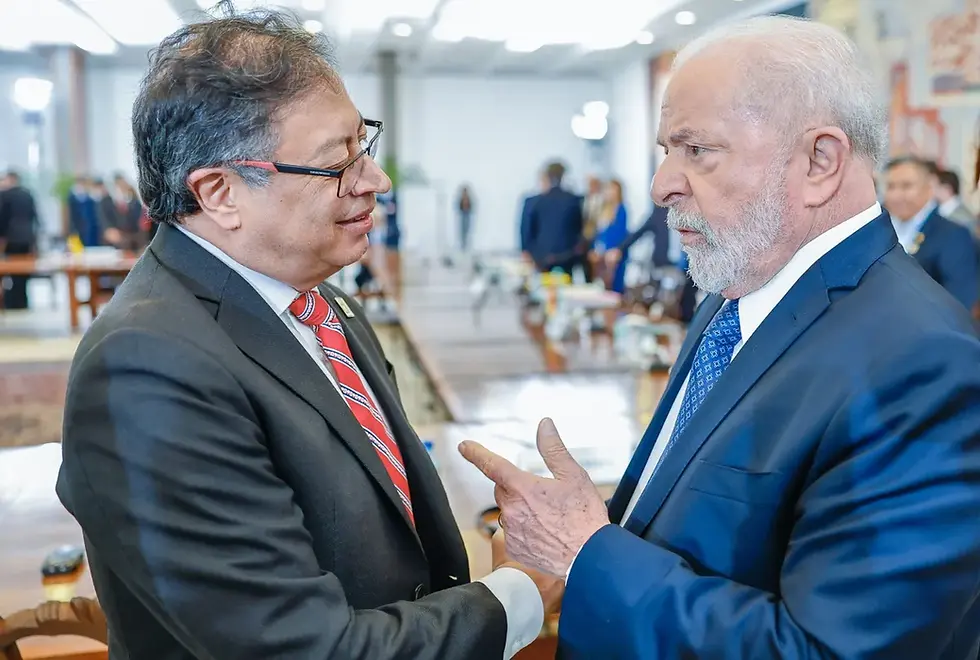Continuity or Change? Claudia Sheinbaum's Plan for Mexico
- Neil Daniel Figueroa

- Dec 9, 2024
- 8 min read
Written by Neil Daniel Figueroa (MSc Political Science)
Claudia Sheinbaum, the newly elected president of Mexico, has come to occupy a pivotal position in the country’s evolving political landscape. As the first woman to assume this role, Sheinbaum inherits not only the aspirations of millions but also a complex legacy from her predecessor, Andrés Manuel López Obrador (AMLO). This article explores the remarkable opportunity Sheinbaum has to address some of Mexico’s most pressing issues through thoughtful policy changes, effective governance, and strategic international relationships. By building on AMLO’s political foundation while confronting critical challenges such as violence, economic stagnation and inequality, Sheinbaum can usher in a new era of progress for Mexico.
The following sections will explore Sheinbaum’s inheritance from AMLO, the strategic design of her cabinet, the current economic landscape, and Mexico’s positioning in international relations, culminating in a synthesis of how Sheinbaum can navigate these intricate terrains to effect meaningful change.

Andrés Manuel López Obrador’s Legacy
AMLO’s presidency has left an indelible mark on Mexico, characterised by both notable advancements and formidable challenges. His administration prioritised social welfare, anti-corruption, and poverty reduction, garnering substantial public support. Programs aimed at increasing the minimum wage and enhancing social programs sought to address deep-rooted inequalities, lifting millions out of poverty. According to the National Council for the Evaluation of Social Development Policy (CONEVAL), approximately 5 million people were lifted out of poverty during AMLO’s administration, reflecting the impact of these social policies (Suárez, 2024). However, AMLO’s presidency also faced criticism for its handling of violence, particularly concerning organised crime. A report by the Mexican National Institute of Statistics and Geography (INEGI) revealed that the murder rate reached a record high during his tenure, with over 35,000 homicides reported in 2021 alone (INEGI, 2021). This persistent violence has overshadowed many of AMLO’s social achievements, leading to a climate of insecurity that weighs heavily on the population.
In addition, his discursive and budgetary attack on many public institutions under the name of “Republican Austerity” and corruption considerably affected both the capacity of the Mexican State in many areas and drove a negative public perception of such institutions. Most notably, his final reform on the Judiciary garnered much disapproval even within members of his own party.
Sheinbaum, as AMLO’s direct successor, finds herself at the crossroads of this legacy. The societal context in which Sheinbaum assumes the presidency is crucial. The Mexican population, weary from years of violence and economic stagnation, yearns for effective leadership and tangible results, and will judge much more harshly the next carrier of Obradorism than they did with AMLO.
In addition to social welfare initiatives, AMLO’s policies focused on anti-corruption, seeking to address the deep-rooted issues that have plagued Mexican governance. The establishment of the “hugs, not bullets” discourse aimed to shift focus from military intervention in combating drug cartels to addressing the underlying socio-economic issues that fuel violence (O’Neil, 2019). While this approach garnered support for its humanitarian focus, critics argued it failed to yield significant results in reducing crime rates, partly because AMLO also paradoxically expanded the role of the military in public life. The legacy of AMLO’s presidency is thus one of great contrasts, and Sheinbaum must confront it to achieve effective resolutions.
The Design of Sheinbaum’s Cabinet
A significant aspect of Sheinbaum’s strategy lies in her carefully curated cabinet, which comprises individuals with strong analytical backgrounds and extensive experience in governance, as well as “heavyweights” from the previous administration. For instance, her appointment of Rogelio Ramírez de la O as Minister of Finance, a seasoned economist, signals her commitment to sound fiscal management and economic reform. His previous experience in both the private sector and academia will be instrumental in navigating the complex economic challenges facing the nation (Government of Mexico, 2024). This emphasis on informed decision-making is a critical departure from previous administrations, which sometimes prioritised political loyalty over technical competence.
The significance of a well-structured cabinet extends beyond individual appointments; it influences the overall effectiveness and efficiency of governance. By selecting cabinet members who utilise empirical evidence in their decision-making processes, she can enhance the quality of policies and initiatives implemented during her presidency. Having a qualified majority in Congress is the key for Sheinbaum to promote her political agenda, at least until legislative elections in 2027.
Mexico’s political landscape is characterised by a history of entrenched interests and power struggles, which often hinder effective governance. Sheinbaum’s ability to navigate these intricacies will determine the success of her administration. Building alliances within Congress and fostering collaboration with civil society will be essential in advancing her policy agenda.
Current Economic Landscape and Commitments
As Sheinbaum assumes the presidency, she faces a sluggish economy characterised by low growth and budgetary challenges. The International Monetary Fund (IMF) projects Mexico’s GDP growth at around 1.2% for 2024, signalling a need for urgent economic revitalisation (IMF, 2023). This stagnation is compounded by the lingering effects of the COVID-19 pandemic and the global economic downturn, which have disproportionately affected vulnerable populations. The combination of these factors presents a formidable challenge for Sheinbaum as she seeks to implement policies that stimulate growth while addressing social inequalities.
During AMLO’s administration, efforts to raise the minimum wage were successful in lifting millions out of poverty. However, Sheinbaum must grapple with the need to sustain this momentum while fostering an environment conducive to economic growth. The key lies in recognising the interplay between social policies and economic development. While increasing wages contributes to poverty alleviation, sustainable economic growth requires investment in infrastructure, education, and innovation. Initiatives in these areas can help stimulate the economy while also addressing social inequality. Investing in education is particularly crucial, as it equips individuals with the skills necessary to thrive in a rapidly changing job market. By prioritising access to quality education and vocational training, Sheinbaum can empower a generation of workers who can contribute to Mexico’s economic resurgence.
The economic landscape is further complicated by Mexico’s reliance on foreign investment and trade, particularly with the United States. Diversifying trade partnerships and reducing dependence on a single market can enhance economic stability and create new opportunities for growth. In this regard, Sheinbaum’s administration can leverage Mexico’s strategic location and natural resources to attract foreign investment in sectors such as renewable energy and technology (Levy, 2024) The ongoing global shift towards sustainability presents an opportunity for Mexico to position itself as a leader in green technologies, which can drive economic growth while addressing pressing environmental concerns.
Moreover, Sheinbaum’s economic agenda must also address the informal sector, which comprises a significant portion of the Mexican economy. Estimates suggest that over 60% of workers are employed in informal jobs, often lacking social protections and job security (World Bank, 2022). By creating policies that promote formalisation, such as tax incentives, streamlined bureaucratic processes and reductions in work hours, Sheinbaum can enhance labour market conditions and improve workers’ rights.
The question of sustainability looms large in Sheinbaum’s economic agenda. By investing in renewable energy sources and implementing policies that promote sustainable agriculture and conservation, Sheinbaum can create a more resilient economy that addresses the dual challenges of poverty and environmental degradation. This focus on sustainability can also position Mexico as a leader in global climate initiatives, attracting international partnerships and investment.
Mexico’s Positioning on the Global Stage
Mexico’s international relations are crucial for addressing the myriad challenges facing the country. Sheinbaum’s administration must prioritise diplomatic initiatives that enhance Mexico’s standing on the global stage, particularly in its relationships with neighbouring countries and global powers.
The relationship with the United States is particularly significant. As Sheinbaum seeks to establish her foreign policy framework, she must navigate the complex dynamics of U.S.-Mexico relations. Fostering dialogue with U.S. officials to establish a cooperative framework that addresses mutual concerns such as migration, drug trafficking, and environmental issues will be paramount. The complexity of these relationships requires a nuanced approach that recognises the interdependence of the two countries, as demonstrated by the fact that they are each other’s largest trading partner. The U.S.-Mexico-Canada Agreement (USMCA), which replaced NAFTA, remains a critical framework for economic cooperation which is due to be renegotiated in 2026. Sheinbaum should work to strengthen trade ties while ensuring that Mexico’s interests are adequately represented. Given the challenges faced during the AMLO-Trump administrations on many issues, the coming Trump mandate will be pivotal in determining the strength of this relationship as a whole.
Beyond the U.S., Sheinbaum has an opportunity to strengthen Mexico’s relationships within Latin America. The recent leftward shift in several South American countries presents an opportunity for Mexico to engage with like-minded governments. Countries such as Brazil, Guatemala, Colombia and Chile are led by leftist administrations that prioritise social equity and economic integration. Mexico can play a leadership role in fostering regional cooperation and addressing common challenges such as economic inequality and environmental sustainability. Strengthening ties with regional organisations such as the Community of Latin American and Caribbean States (CELAC) can facilitate cooperation on issues of mutual interest. This multilateral approach can also provide Mexico with leverage in negotiations with larger global powers.
In addition to regional cooperation, Sheinbaum’s administration must also navigate its relationship with global powers such as China and the European Union. China’s growing influence in Latin America presents both opportunities and challenges for Mexico. On one hand, increased trade and investment from China can spur economic growth; on the other hand, Mexico must carefully manage its relationship to ensure it does not become overly dependent on such a powerful economic partner. Sheinbaum should prioritise fostering a balanced approach that promotes trade with China while also strengthening ties with traditional partners in North America and Europe.
Regarding the European Union, Sheinbaum’s administration has the chance to strengthen relationships with key players like Spain, Germany, and France. Despite a rocky start, including the omission of a Spanish delegation from her inauguration (Morán, 2024), there is potential for a robust multifaceted relationship with Spain. Mexico’s involvement in addressing global issues such as the war in Ukraine and humanitarian crises can position the country as a significant player on the international stage. Engaging in diplomatic initiatives that promote cultural exchange, trade partnerships, and collaborative research will enhance Mexico’s standing in Europe.
Furthermore, addressing historical grievances and fostering mutual respect will be crucial in rebuilding relationships with countries that may have experienced friction during AMLO’s presidency. As Mexico seeks to increase its global presence, Sheinbaum should prioritise partnerships that foster dialogue on pressing issues such as climate change, migration, and war. By aligning Mexico with global initiatives, Sheinbaum can amplify the country’s voice on the world stage and contribute to addressing shared challenges.
Conclusion
Claudia Sheinbaum’s presidency presents a historic opportunity to address Mexico’s most pressing issues. By leveraging her predecessor’s political foundation, strategically designing her cabinet, ensuring sustainable and equitable economic growth, and strengthening international relationships, she can usher in a new era of progress for Mexico. The path forward requires bold decisions and a commitment to addressing the complexities of governance.
The challenges facing Mexico are significant, but not insurmountable. Sheinbaum’s leadership will be judged not only by her ability to navigate the intricate political landscape but also by her capacity to translate promises into tangible results. By prioritising social equity, economic revitalisation, regional security and effective governance, she can build a legacy that can guarantee another Morena administration in 2030.
The historical significance of Sheinbaum’s presidency cannot be understated. Sheinbaum can pave the way for a Mexico that not only overcomes its current challenges but emerges as a beacon of hope and progress in the region. As she moves forward, the need for collaboration becomes paramount. Engaging with civil society, private sector stakeholders, and the international community will be crucial for fostering an environment where shared goals can flourish. With the next 6 years in Mexico’s highest office, she has the potential to inspire hope and resilience in a nation yearning for both continuity and change.



Comments